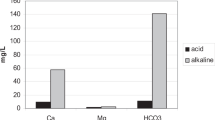Abstract
The purpose of this study was to examine whether oral exposure to aluminum (Al) can affect the human immune system. Eighteen healthy volunteers (mean age 42, 28–57 yr) were divided into a test group (9 females, 4 males) and a referent group (3 females, 2 males). Over 6 weeks, the test subjects ingested 10 ml of antacid (aluminum hydroxide, 59 mg Al/ml) three times daily. Aluminum was analyzed in urine before and during the exposure period (ICP-MS). Blood samples were used for analysis of lymphocyte subpopulations, mitogen-induced lymphocyte proliferation and in vitro production and circulating plasma concentrations of immunoglobulin (Ig) A, IgG, IgM, interleukin (IL) -2 and IL-4. Urinary Al concentration in the test subjects was approximately 10- to 20-fold higher than in the referent group during exposure. This indicates that ingestion of an Al-containing antacid is associated with an Al absorption far above that originating from food and drinking water. In both referents and test subjects the lymphocyte subpopulations, lymphocyte proliferation and the in vitro Ig and IL production showed similar, time-dependent changes before as well as during the exposure period. No major differences were seen between the referent and test groups regarding the immune parameters, except for a slightly smaller CD8+CD45R0+ population (primed cytotoxic T-cells), in the exposed individuals as compared to the referents. The results also show that subjects on antacid therapy may constitute a suitable population for studying biological effects of high-dose oral exposure to Al.
Similar content being viewed by others
References
Chou KY, Chan M, Bias WB. 1996Differential expression of the down-regulatory function of CD8 cells in trichsanthin-induced immunosuppression and its genetic control in humans. Eur J Immunogen 23, 29–40.
Flaten TP, Alfrey AC, Birhall JD, Savory J, Yokel RA. 1996Status and future concerns of clinical and environmental aluminum toxicology. J Toxicol Environ Health 48, 527–541.
Golub MS, Takeuchi PT, Gershwin ME, Yoshida SH. 1993 Influence of dietary aluminum on cytokine production by mitogen-stimulated spleen cells from Swiss Webster mice. Immunopharmcol Immunotoxicol 15, 605–619.
Kemeny DM, Noble A, Holmes BJ, Diaz-Sanchez D. 1994Immune regulation: a new role for the CD8C T cell. Immunology Today 15, 107–110.
Lombardi G, Sidhu S, Batchelor R, Lechler R. 1994Anergic T cells as suppressor cells in vitro. Science 264, 1587–1589.
Maes M, Bosmans E, Scharpé S et al. 1997Components of biological variation in serum soluble transferrin receptor: relationships to serum iron, transferrin and ferritin concentrations, and immune and haematological variables. Scand J Clin Lab Invest 57,31–41.
Nelson RJ, Demas GE. 1997Role of melatonin in mediating seasonal energetic and immunologic adaptations. Brain Res Bull 44, 423–430.
Nicklas W. 1992Aluminum salts. Res Immunol 143, 489–494.
Nordal KP, Dahl E, Alrechtsen D et al. 1988Aluminium accumulation and immunosuppressive effects in recipients of kidney transplants. Br Med J 297, 1581–1582.
Pennington JAT, Jones JW. 1988Dietary intake of aluminum. In: Gitelman HJ, eds. Aluminum in Health, a Critical Review. New York: Marcel Dekker, pp. 67–98.
Priest ND, Talbot RJ, Austin JG et al. 1996The bioavailability of 26Al-labelled aluminium citrate and aluminium hydroxide in volunteers. BioMetals 9, 221–228.
Ramanathan VD, Badenoch-Jones P, Turk JL. 1979Complement activation by aluminium and zirconium compounds. Immunology 37, 881–888.
Rodger RSC, Muralikrishna GS, Halls DJ et al. 1991Ranitidine suppresses aluminium absorption in man. Clin Science 80, 505–508.
Sjögren B, Gustavsson P, Hogstedt C. 1990Neuropsychiatric symptoms among welders exposed to neurotoxic metals. Br J Ind Med 47, 704–707.
Slanina P, Frech W, Ekström LG, Lööf L, Slorach S, Cedergren A. 1986Dietary citric acid enhances absorption of aluminium in antacids. Clin Chem 32,539–541.
Van Loveren H, Steerenberg PA, Vos JG. 1995Early detection of immunotoxicity: from animal studies to human biomonitoring.Toxicol Lett 77, 73–80.
Weberg R, Berstad A. 1986Gastrointestinal absorbtion of aluminium from single doses of aluminium-containing antacids in man. Eur J Clin Invest 16, 428–432.
Weisglas-Kuperus N, Sas TCJ, Koopman-Esseboom C et al. 1995 Immunologic effects of background prenatal and postnatal exposure to dioxins and polychlorinated biphenyls in Dutch infants. Pediatr Res 38, 404–410.
Wicklund Glynn A, Thuvander A, Sundström B, Sparen A, Danielsson LG, Jorhem L. 1999Does aluminium stimulate the immune system in male rats after oral exposure? Food Add Contam 16, 129–135.
Wills MR, Savory J. 1989Aluminium and chronic renal failure: sources, absorption, transport and toxicity. Crit Rev Clin Sci 27, 59–107.
Yao XL, Jenkins ED, Wisniewski HM. 1994Effects of Aluminum Chloride on mitogenesis, mitosis, and cell cycle in human short-term whole blood cultures: Lower concentrations enhance mitosis. J Cell Biochem 54, 473–477.
Yoshida S, Gershwin ME, Keen CL, Donald JM, Golub MS. 1989 The influence of aluminium on resistance to Listeria monocytogenes in Swiss-Webster mice. Int Arch Allergy Appl Immunol 89, 404–409.
Author information
Authors and Affiliations
Rights and permissions
About this article
Cite this article
Gräske, A., Thuvander, A., Johannisson, A. et al. Influence of aluminium on the immune system – an experimental study on volunteers. Biometals 13, 123–133 (2000). https://doi.org/10.1023/A:1009215924071
Issue Date:
DOI: https://doi.org/10.1023/A:1009215924071




